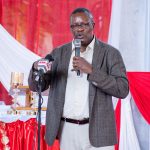Kitui County is among 23 counties in the country classified as Arid and Semi-Arid Lands (ASALs), it is also among the marginal counties due to its hot and dry climate.
However, this is about to change as a program by the Kenya Forest Research Institute (KEFRI) and Japan International Cooperation Agency (JICA) has developed a wonder tree species that is greening the dry and patched landscapes of the county.
The Chief Research Scientist at KEFRI Dr. James Ndufa says that Melia volkensii locally known as Mukau, “is becoming the wonder tree for the dryland landscapes,” he says and adds, “the tree needs less moisture when growing, which is well suited for the drylands.”
The Strengthening Forestry Sector Development and Community Resilience to Climate Change through Sustainable Forest Management and Landscape Restoration (SFS-CORECC) project, being implemented by the Japan International Cooperation Agency (JICA) and the Kenya Forest Research Institute (KEFRI) is fast changing the narrative of dry and unproductive in Kitui County.
Apart from greening the once bare and barren landscapes, the project is also building the technical capacity of researchers at KEFRI in developing tree species that can do well in the dryland areas and in the process aid the government in realizing the envisaged goals in the 10 year National Landscape and Ecosystem Restoration Strategy of growing 15 billion trees by 2032 thus realizing the 30% tree cover of the land area.
Dr. Ndufa notes that the project is in eight of the 23 counties in the country classified as Arid and Semi-Arid Lands (ASALs). They include; Embu, Nyeri, Taita Taveta, Kitui, Makueni, Tharaka Nithi, Kilifi, and Kwale counties.

The project has seen the development of dryland tree species known by its scientific name Melia volkensii, locally known as Mukau. Mukau has turned out to be the wonder tree in the drylands, it requires little amounts of water and is well suited for the sandy loam soils that are easily drained.
“The tree grows fast and within 18 years it is ready for harvesting,” says Dr. Ndufa, adding, “As Mukau tree grows, farmers are allowed to plant legumes including beans, nzuu, cowpeas, which add to the household income.” The scientists are upbeat that, given that Melia Volkensii has many branches with leaves, it has the much-needed biomass required in climate change mitigation because it has a large surface area to absorb carbon.
The tree which is being grown on a commercial basis is also providing a source of income to the farmers, in this KEFRI is also seeing an opportunity for the local community to adapt to agroforestry.
The opportunity presented by Melia Volkensii could see the country reduce its imports of hardwood as Mukau has the same benefits as those found in mahogany which is being imported from such countries as the Democratic Republic of Congo. “Demand for timber in Kenya is rising, yet the supply largely depends on imports from other countries,” says Dr. Ndufa and adds, “imports could be replaced by domestic supplies of timber once the production of Mukau increases.”
While it has been a common belief that drylands of the country are low potential areas according to Sessional Paper No. 10 of 1965, investment in climate change mitigation and ecosystem restoration is turning the once desolate and barren regions of the country into productivity and solution to the climate change debacle.
The drylands are the most preferred because there is more land available than in the high-potential areas hence commercial forestry is more feasible in Kenya’s drylands.






